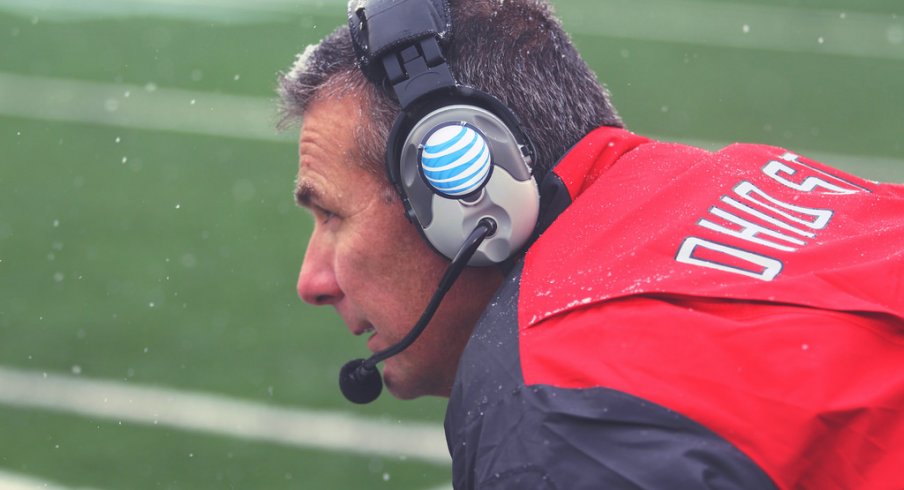Three-star in-state linebacker CJ Sanna commits to Ohio State.
Context is king.
Although there may be over 100 plays called in a college football game these days, every single one of them is chosen based on dozens of factors. All fans usually recognize the broad scenarios such as score, down-and-distance, and field position that are taken into account when a coaching staff is choosing what play to call from the dozens on a play-sheet in front of him. But the minute details are what often make or break those calls.
'What did the opponent do last time they were in the same scenario? What about 3 weeks ago?'
'What did a specific player do on the last play?'
'What did we practice all week?'
There are countless elements that can affect the success or failure of a specific play before the ball is ever snapped. Though coaches can't control whether all 11 players execute their plan perfectly every time, they can certainly put them in better (and worse) situations to succeed.
When looking back at Ohio State's 2014 national championship season, there are literally dozens of highlights that we can point to as key moments in their run. Many of those moments, such as Joey Bosa ending the Penn State game with a sack, Michael Thomas and Devin Smith simply out-running Spartan defensive backs, or Cardale Jones bowling over a nose tackle for a first down, were examples of incredible effort from one or two individuals.
But some of the most critical moments of that campaign were decisions made on the sidelines which, when coupled with great effort on the field, produced game-changing results. Let's take a look at a few of the best examples.
J.T. Barrett runs over Penn State
Situation: Tied at 17 and heading into overtime in Happy Valley, OSU made their freshman quarterback the primary ball-carrier against one of the nation's best run defenses.
The play-call: Tight zone read-option
Why it worked: Though Ezekiel Elliott would crack the 100-yard mark that evening, he'd do so in a relatively inefficient manner, averaging just four yards-per-carry against a Penn State defense that would finish second nationally in that category. With an early lead slowly slipping away, the Buckeyes began to recognize the strongest point of the Nittany Lion defense lay inside, led by middle linebacker Mike Hull, who would rack up a career high 19 tackles that night.
OSU had relied heavily on their base, tight zone running play that night; a play that has long been the foundation of the OSU offense. To even the playing field though, the Buckeyes would allow Barrett to option aggressive defensive end C.J. Olaniyan and allowing left tackle Taylor Decker to take out Hull and the other linebackers immediately.
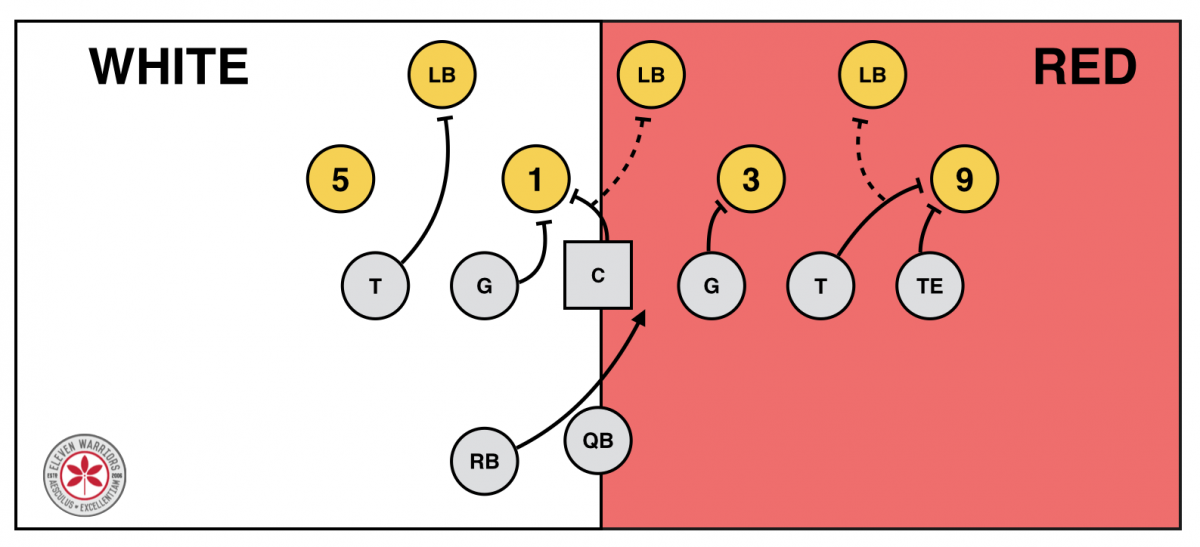
After experimenting with the call a few times near the end of regulation in an effort to run out the clock, it was clear that offensive coordinator Tom Herman's game plan had changed as the two teams headed to the extra session. After running the tight zone on first down, Herman tacked on the option on second, and Barrett was off to the races.

OSU would call the exact same play again on the very next play, finding the end zone in just three plays and stealing the momentum back from the home team. After running it for the third time in a row to open the second overtime, Penn State finally adjusted, changing their scheme to account for the running Barrett, which would open up the quarterback draw that would ultimately be the game-winning score two plays later.
The call was not just a success because it led to a couple big plays, but also because it forced the defense to change out of a scheme that had been shutting down the OSU offense for quite some time.
Steve Miller Steals the Sugar Bowl
Situation: After OSU scored to lead for the first time since early in the first quarter at 27-21, Alabama faced third & six from their own 36-yard line.
The play-call: 2-Deep zone blitz
Why it worked: With Alabama quarterback Blake Sims struggling to find any consistency with all receivers not named "Amari Cooper" that night, the Buckeyes could guess where Sims might be looking on this critical third down conversion attempt. Though Sims was a senior, he had only seen a handful of these kinds of stressful scenarios as a first-year starter.
Instead of lining up and hoping to win a straightforward matchup against the most talented wide-out in the nation, OSU decided to put the onus on Sims to see past an unexpectedly complex coverage. The Buckeyes brought in their 3-3-5 'nickel' package that aligned with three deep safeties, with only three down linemen up front.
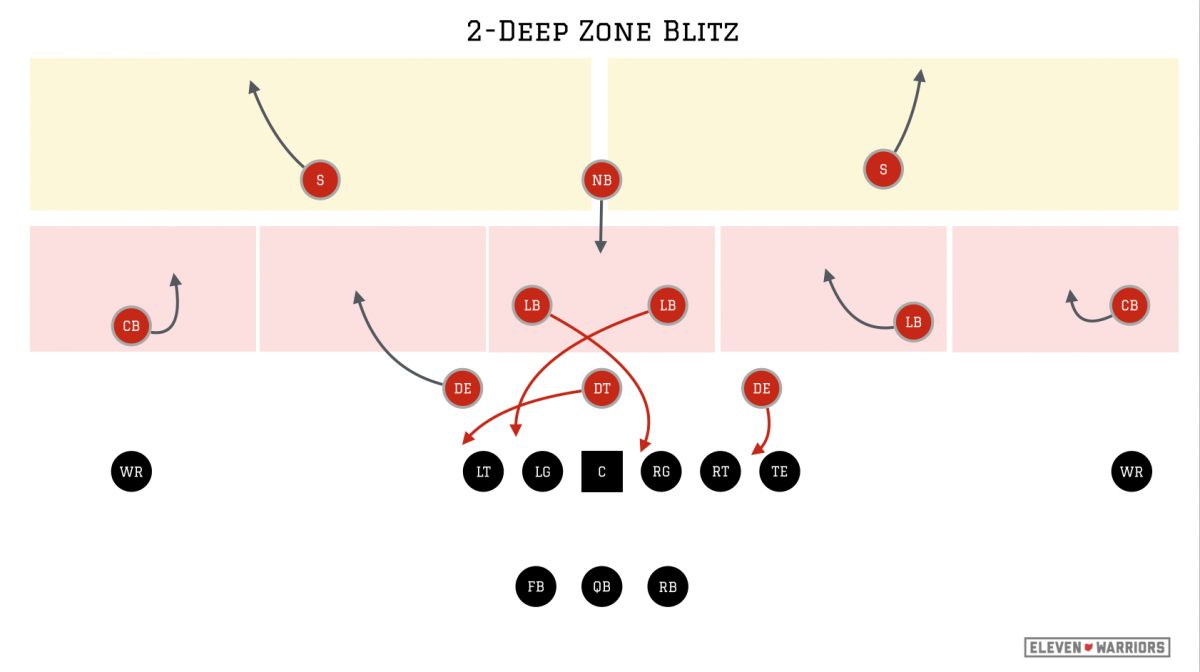
The Buckeyes would ultimately play a simple, two deep zone while the third safety, Armani Reeves dropped down to play the short, middle zone left unoccupied as both inside linebackers blitzed Sims. To ensure the Buckeyes weren't left exposed by blitzing too many people, end Steve Miller dropped into a short "hook" zone, giving the defense five underneath zones to defend the six needed yards.
Sims locked on to Cooper almost immediately after the snap, yet never saw or expected Miller to drop directly in front of his intended receiver. The Canton native was able to make an easy interception with a return that would finish in the end zone, securing every ounce of momentum in favor of the Buckeyes in the process.
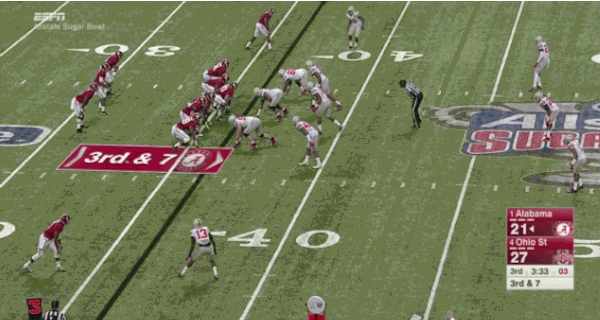
While defensive coordinators Luke Fickell and Chris Ash couldn't have known where Cooper would line up or finish his route on the play, they had to do something to make Sims and the Crimson Tide offense uncomfortable while still ensuring they weren't exposed over the top in case the pass was completed. This bet paid off big.
Zeke runs through The Team Up North
Situation: With third-string quarterback Cardale Jones forced into the first important action of his career, OSU faced a crucial fourth & one situation with just under five minutes to play against their biggest rivals.
The play-call: Shotgun triple-option
Why it worked: Down by a touchdown, the Wolverine defense had begun to ratchet up their aggressiveness, sensing an opportunity to potentially get back in a game they had little business winning. Meanwhile, the Buckeyes could put the game away with a long drive or another touchdown, keeping their championship hopes alive.
Since Barrett limped off the field earlier on the drive, the Buckeye offense had looked very different from the dominant unit fans had grown accustomed to seeing throughout the season. What they saw instead was a disjointed group led by a quarterback struggling to sync up with his receivers, and relying heavily on his legs to pick up yardage.
After taking a timeout to discuss their options, Urban Meyer and his staff came out in a formation they had rarely used. Jones was in the shotgun with Ezekiel Elliott to his right, and wide receiver Jalin Marshall to his left. Marshall's presence in the backfield signaled a likely jet sweep around the right side with Elliott as a lead blocker, as they had done the week before against Indiana with great success.
But this was no jet sweep, as instead of handing to Marshall, Jones appeared to read the right defensive end, who was initially left unblocked, and handed off to Elliott on a variation of the tight zone. Instead of leaving the end alone to be read on the play, tight end Nick Vannett crashed down from the other side, creating a "split zone" look. Meanwhile, Jones and Marshall added window dressing in the form of an option look, appearing as though the two would come around the right end.

Vannett's action proved to be even more crucial to the play's success, as the defense was in man coverage, meaning safety Delano Hill was following #81 wherever he went. In this instance, that happened to be in the exact opposite direction of the ball carrier.
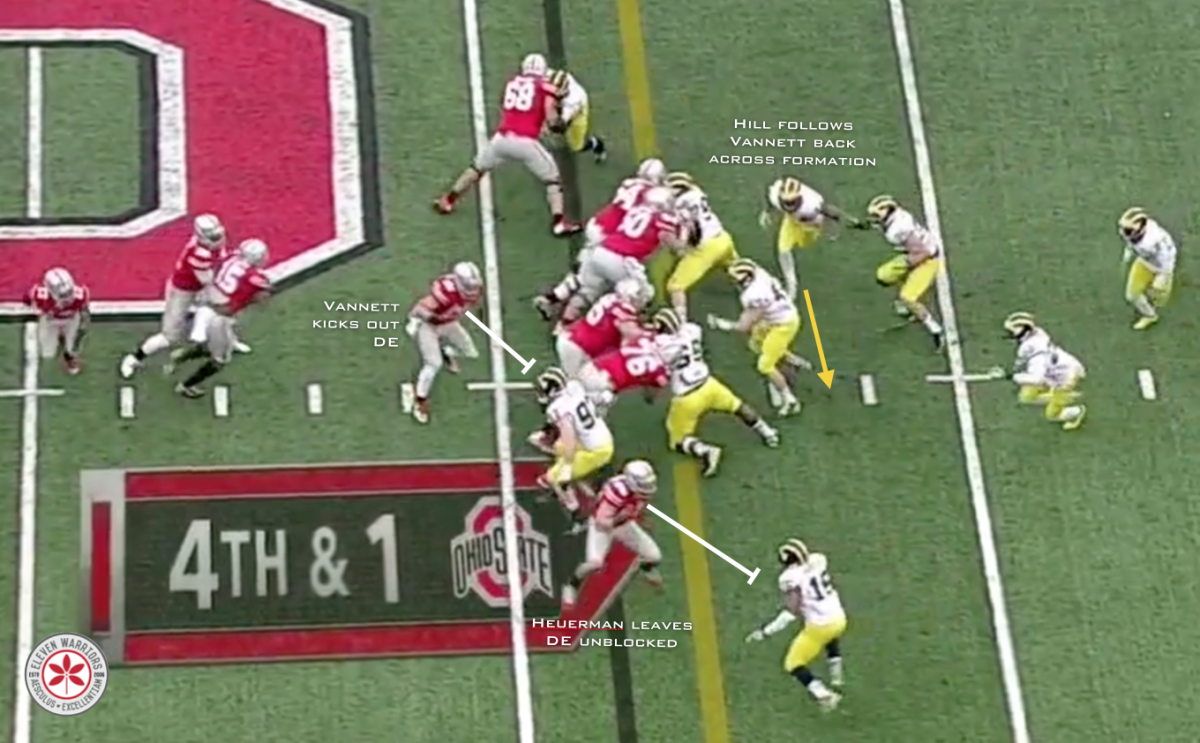
The result is a big gap between the left guard and tackle, which proved to be more than enough room for Elliott to pick up the first down and plenty more.
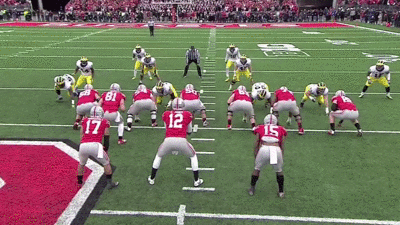
The play would seal a victory over the Buckeyes' biggest rival, but also build confidence for a unit that was looking to replace their signal caller for the second time that season. Of course, it would also springboard Elliott to a huge postseason that has set the stage for an even bigger 2015. But this play wasn't just chosen as a 'great call' because of its success, or what came after it.
This was a great call because it was the perfect counter to what the Buckeyes shown all year. Undoubtedly, the defense had been looking for Marshall on the sweep, given his success with the play just one week earlier. OSU hadn't shown much from this look, leaving this "split zone" adjustment as a compliment few would expect, and there is a decent chance the staff had been saving this call for just this kind of moment.
The jet sweeps had been the jabs, but this was the knockout punch.
